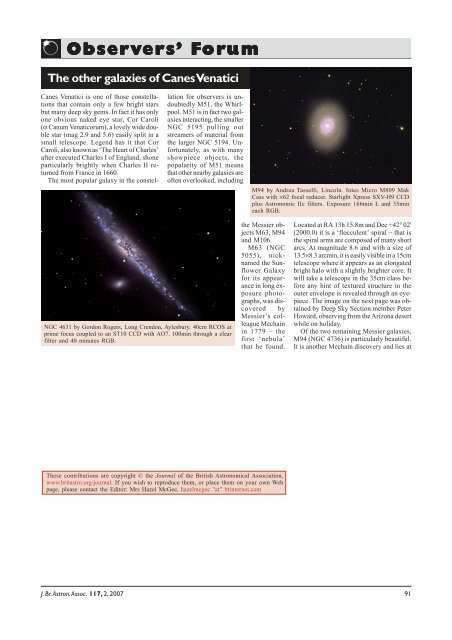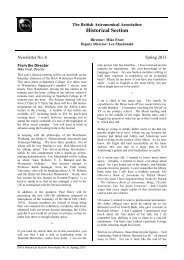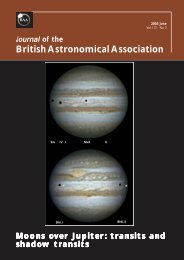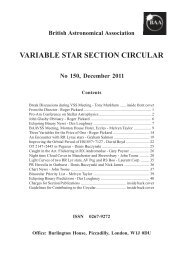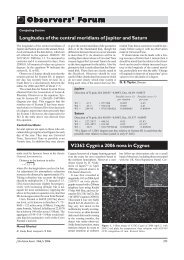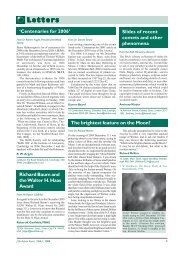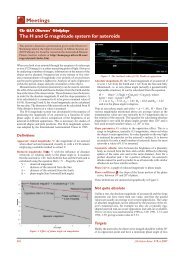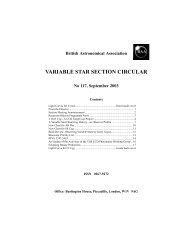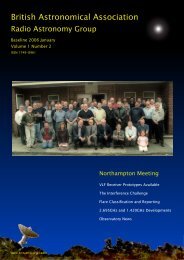Observers' Forum - British Astronomical Association
Observers' Forum - British Astronomical Association
Observers' Forum - British Astronomical Association
Create successful ePaper yourself
Turn your PDF publications into a flip-book with our unique Google optimized e-Paper software.
Obser Observers<br />
Obser ers ers’ ers F FFor<br />
F or orum or um<br />
The other galaxies of Canes Venatici<br />
Canes Venatici is one of those constellations<br />
that contain only a few bright stars<br />
but many deep sky gems. In fact it has only<br />
one obvious naked eye star, Cor Caroli<br />
(α Canum Venaticorum), a lovely wide double<br />
star (mag 2.9 and 5.6) easily split in a<br />
small telescope. Legend has it that Cor<br />
Caroli, also known as ‘The Heart of Charles’<br />
after executed Charles I of England, shone<br />
particularly brightly when Charles II returned<br />
from France in 1660.<br />
The most popular galaxy in the constel-<br />
lation for observers is undoubtedly<br />
M51, the Whirlpool.<br />
M51 is in fact two galaxies<br />
interacting, the smaller<br />
NGC 5195 pulling out<br />
streamers of material from<br />
the larger NGC 5194. Unfortunately,<br />
as with many<br />
showpiece objects, the<br />
popularity of M51 means<br />
that other nearby galaxies are<br />
often overlooked, including<br />
NGC 4631 by Gordon Rogers, Long Crendon, Aylesbury. 40cm RCOS at<br />
prime focus coupled to an ST10 CCD with AO7. 100min through a clear<br />
filter and 40 minutes RGB.<br />
M94 by Andrea Tasselli, Lincoln. Intes Micro M809 Mak<br />
Cass with ×62 focal reducer. Starlight Xpress SXV-H9 CCD<br />
plus Astronomic IIc filters. Exposure 166min L and 35min<br />
each RGB.<br />
the Messier objects<br />
M63, M94<br />
and M106.<br />
M63 (NGC<br />
5055), nicknamed<br />
the Sunflower<br />
Galaxy<br />
for its appearance<br />
in long exposurephotographs,<br />
was discovered<br />
by<br />
Messier’s colleague<br />
Mechain<br />
in 1779 – the<br />
first ‘nebula’<br />
that he found.<br />
These contributions are copyright © the Journal of the <strong>British</strong> <strong>Astronomical</strong> <strong>Association</strong>,<br />
www.britastro.org/journal. If you wish to reproduce them, or place them on your own Web<br />
page, please contact the Editor: Mrs Hazel McGee, hazelmcgee "at" btinternet.com<br />
Located at RA 13h 15.8m and Dec +42° 02'<br />
(2000.0) it is a ‘flocculent’ spiral − that is<br />
the spiral arms are composed of many short<br />
arcs. At magnitude 8.6 and with a size of<br />
13.5×8.3 arcmin, it is easily visible in a 15cm<br />
telescope where it appears as an elongated<br />
bright halo with a slightly brighter core. It<br />
will take a telescope in the 35cm class before<br />
any hint of textured structure in the<br />
outer envelope is revealed through an eyepiece.<br />
The image on the next page was obtained<br />
by Deep Sky Section member Peter<br />
Howard, observing from the Arizona desert<br />
while on holiday.<br />
Of the two remaining Messier galaxies,<br />
M94 (NGC 4736) is particularly beautiful.<br />
It is another Mechain discovery and lies at<br />
J. Br. Astron. Assoc. 117, 2, 2007 91
92<br />
Observers’ <strong>Forum</strong><br />
M63 imaged by Peter Howard, Grange-over-Sands, Cumbria,<br />
observing from Arizona. C11 SCT with Hyperstar adapter and<br />
SBIG ST237A CCD. 5×45 seconds Track and Accumulate.<br />
RA 12h 50.9m and Dec +41° 07'. It is<br />
brighter in the eyepiece than M63, with a<br />
strongly condensed and much brighter central<br />
core. Surrounding the core, and visible<br />
in detailed images, is an active star-forming<br />
region suggesting the galaxy has undergone<br />
some catastrophic event in the last few million<br />
years. Beyond this region of hot young<br />
blue stars is a region of older yellow population<br />
stars and beyond that yet another<br />
faint star-forming ring. M94 really is an intriguing<br />
galaxy. The image here, by Section<br />
member Andrea Tasselli, shows hints of this<br />
multiple structure.<br />
The final Messier galaxy is M106 (NGC<br />
4258) at RA 12h 19.0m and Dec +47° 18'<br />
− another beautiful object (mag 8.4, size<br />
20×8.4 arcmin) and another intriguing one.<br />
It is a galaxy that appears<br />
to have had an unsettled recent<br />
past with star-forming<br />
regions visible and a central<br />
core that it still in turmoil.<br />
The core is bright in radio<br />
waves and X-rays, where<br />
twin jets have been detected<br />
running the length of the<br />
galaxy. M106 was among<br />
the objects listed by Carl<br />
Seyfert in 1943 when he<br />
published his list of what<br />
are now known as Seyfert<br />
Galaxies – objects with active<br />
cores where huge<br />
amounts of gas are thought<br />
to be falling into a massive<br />
central black hole. Visually<br />
the galaxy is easy. Under a<br />
reasonable sky a 15cm reflector<br />
will show an elongated<br />
halo with a bright central<br />
core, while a 35cm telescope<br />
will show hints of<br />
spiral structure. Peter<br />
Howard obtained the image<br />
shown here, again observing<br />
from the Arizona desert.<br />
A spectacular non-<br />
Messier galaxy in Can<br />
Venatici is the edge on spiral<br />
NGC 4631. Lying well<br />
south of Cor Caroli and<br />
close to the border with<br />
Coma Berenices at RA 12h<br />
42.1m and Dec +32° 32',<br />
this is a galaxy that Messier<br />
Daytime photometry of Comet McNaught<br />
The spectacle of the brightest comet for several<br />
decades offered the tempting opportunity<br />
to not only try and capture an image of<br />
comet C/2006 P1 (McNaught) during the<br />
daytime but also to attempt to make accurate<br />
photometric measurements of its brightness.<br />
The challenge promised to be difficult<br />
in that the comet would remain both close to<br />
the Sun and at a low altitude in the sky.<br />
Figure 1. Two stacked series of images taken in daylight on 2007<br />
January 14. (a) 201×4sec exposures at 14:44−15:11 UT, (b) 18×6sec<br />
and 14×8sec exposures at 15:33−15:44 UT plus 28×12sec exposures<br />
at 15:55−16:03 UT.<br />
Whether the comet would be lost in the glare<br />
of the Sun was the big question.<br />
A first observing attempt was made on<br />
2007 January 10, when clear skies arrived<br />
during the early afternoon. A 50×50mm ND5<br />
neutral density filter was fitted to a Takahashi<br />
60mm aperture FS60C refractor thereby<br />
blocking out 99.999% of the light flux. The<br />
telescope was also equipped with a Starlight<br />
Xpress SXV-H9<br />
CCD camera and a<br />
standard V filter. The<br />
mount was aligned<br />
on Venus (magnitude<br />
−3.9) and then<br />
slewed to the position<br />
of the comet<br />
under computer<br />
control. Unfortu-<br />
nately, the Vixen<br />
Atlux mount refused<br />
to move the last degree<br />
or so: later investigation<br />
revealed<br />
and his colleagues missed but could easily<br />
have discovered. In a 30cm or larger telescope<br />
it is magnificent, appearing as a<br />
huge tapered spindle of about 17×1.5<br />
arcmin with detailed mottling along its<br />
length. Lying just off its northern edge is<br />
the much fainter elliptical galaxy NGC<br />
4627. An image on the previous page of<br />
NGC 4631 by regular contributor to the<br />
Deep Sky Section, Gordon Rogers, shows<br />
just what a wonderful object this is, and<br />
also shows the companion galaxy NGC<br />
4627. If you like spindle galaxies, another<br />
example nearby is NGC 4244 at RA 12h<br />
17.5m and Dec +37° 49'. Appearing similar<br />
in size to NGC 4631 it is slightly<br />
fainter, but still a superb visual object.<br />
Stewart L. Moore, Director, Deep Sky<br />
Section<br />
M106 by Peter Howard in Arizona, details as before.<br />
that the internal software stopped the telescope<br />
moving if it approached to within<br />
15º of the Sun, presumably as a safety measure.<br />
A dodge around this limitation was hit<br />
upon but by then the Sun was almost setting<br />
and so it was too late to attempt daytime<br />
observation. The ND5 filter was therefore<br />
removed and a number of conventional images<br />
were acquired as the comet sank below<br />
the horizon (see page 61 for an example).<br />
The best opportunity to image the comet<br />
in the daytime occurred a day or two following<br />
perihelion passage on January 12. Fortunately,<br />
January 14 proved to be a dry day<br />
with sunny periods and a second attempt was<br />
made. It was not possible to see any trace of<br />
the comet using 11×80mm binoculars, probably<br />
because of the excessive glare from the<br />
low Sun as well as the fact that the head of the<br />
comet was located a little over 5º east from<br />
the solar limb. Clouds continued to dog attempts<br />
to align the telescope mount on Venus<br />
and so instead the mount was pointed directly<br />
at the Sun, an image of which was<br />
J. Br. Astron. Assoc. 117, 2, 2007
Figure 2. Extinction plot based on the instrumental magnitude (v)<br />
of Vega, and of Venus as it set.<br />
centered within the CCD frame. The telescope<br />
was then offset by the appropriate amount in<br />
RA and Dec. so as to acquire the field containing<br />
the comet, however thick cloud persisted<br />
obscuring any possible view of the comet.<br />
The scope was left to track the position of<br />
the comet in the vague hope that the clouds<br />
would disperse. A good hour passed by with<br />
no let-up as the Sun began to drift towards<br />
the horizon. Then miraculously a totally clear<br />
patch of sky arrived and a 4-second exposure<br />
revealed a small rather stellar point of light<br />
near the centre of the frame. At this exposure<br />
time, the CCD was only one-third saturated<br />
and so it would be possible to remain within<br />
the ‘linear’ region of detector response: an<br />
important requirement for accurate photometry.<br />
A long time-series of exposures was therefore<br />
started at 14:44 UT.<br />
Images of the comet alone taken through a<br />
standard filter are not sufficient for determining<br />
the actual brightness of the comet.<br />
Figure 3. Variation in sky brightness adjacent to the comet showing<br />
declining intensity with time, corresponding to 0.13 mag/atm<br />
(airmass range of the Sun = 4.8−5.9).<br />
To do this requires<br />
separate exposures to<br />
be made of one or more<br />
objects of known<br />
brightness. The most<br />
obvious target at the<br />
time was Venus located<br />
at an elongation of<br />
about 19º east of the<br />
Sun. After more than<br />
200 exposures were<br />
taken of the comet, the<br />
scope was slewed to<br />
Venus and 20 ten-second<br />
exposures recorded.<br />
It was noticed<br />
that the image of Venus<br />
was marginally out of<br />
focus and so the opportunity<br />
was taken to<br />
refocus the 60mm refractor<br />
using the recently-fitted<br />
RoboFocus device to remotely<br />
tweak the rack-and-pinion focuser. Once this<br />
was completed, the scope was repositioned<br />
and further exposures made of the comet as<br />
well as a second set of Venus, before a third<br />
and final set on the comet was completed as<br />
it reached an altitude of 4.5° above the horizon.<br />
Frames were stacked to yield two images<br />
as shown in Figure 1.<br />
The fan-shaped tail is clearly visible against<br />
the intensely bright sky background, and the<br />
central coma was recorded clearly (FWHM*=<br />
(a) 24.9 and (b) 25.7 arcsec, SNR*= (a) 21<br />
and (b) 18). Estimating the actual diameter of<br />
the coma framed against the bright sky is quite<br />
subjective. Photometry was carried out using<br />
measuring apertures in the range, 30−90<br />
arcsec. To put these measurements on an absolute<br />
scale further observations were made<br />
of Venus as it approached the horizon and the<br />
telescope was also pointed in the direction of<br />
the bright star Vega (V=0.03) so that a second<br />
object of known brightness<br />
could be recorded<br />
(15×60sec). These targets<br />
were recorded with<br />
signal-to-noise ratios of<br />
about 300 and 130, and<br />
FWHMs of 11−12<br />
arcsec and 8−9 arcsec<br />
respectively. Note that<br />
the apparent diameter<br />
of Venus at the time was<br />
11 arcsec.<br />
Measurements of<br />
Venus and Vega were<br />
then plotted against atmospheric<br />
thickness to<br />
calibrate the sky so that<br />
the atmospheric extinction<br />
coefficient could be<br />
determined and absolute<br />
photometry could be<br />
applied to the comet<br />
data. Figure 2 illustrates<br />
Observers’ <strong>Forum</strong><br />
the resultant extinction plot, which shows<br />
that the atmosphere remained stable<br />
photometrically speaking, exhibiting a V-band<br />
extinction coefficient of 0.239±0.015 mag/atm.<br />
The stability of the sky conditions is also<br />
exemplified by Figure 3, which comprises a<br />
plot of individual sky brightness measurements<br />
versus time for the first series of comet<br />
exposures. A peak brightness equivalent to<br />
magnitude −1.17 per square arcsecond of sky<br />
was registered, which equates to more than<br />
400 million times brighter than on a really<br />
dark night here in Dorset.<br />
The resultant V-filter photometry corrected<br />
for airmass and seeing yielded the following<br />
results:<br />
2007 Jan 14.624<br />
90 arcsec: −4.94±0.12<br />
60 arcsec: −4.60±0.10<br />
Total integration time = 804sec;<br />
altitude= 12.0−9.6°<br />
2007 Jan 14.658<br />
90 arcsec: −5.01±0.15<br />
60 arcsec: −4.71±0.14<br />
45 arcsec: −4.48±0.14<br />
30 arcsec: −4.05±0.15<br />
Total integration time = 556 sec;<br />
altitude = 7.6−6.6° and 5.3−4.5°<br />
Visual estimates 1 indicated that peak brightness<br />
of Comet McNaught was attained at<br />
Jan 14.2±0.3, some 34 hours post-perihelion,<br />
at a visual magnitude of −5.4±0.2. V-filter<br />
photometry reported here indicates an integrated<br />
brightness of magnitude −4.97±0.11,<br />
confirming the visual lightcurve to within a<br />
precision of about 0.2 magnitude, assuming<br />
that visual observers estimated the integrated<br />
brightness for a coma diameter of 1.5 arcmin.<br />
Richard Miles<br />
Golden Hill Observatory, Stourton Caundle,<br />
Dorset, UK. [rmiles.btee@btinternet.com]<br />
1 http://cfa-www.harvard.edu/icq/Comet<br />
Mags.html<br />
*FWHM = full width at half maximum; SNR =<br />
signal to noise ratio<br />
J. Br. Astron. Assoc. 117, 2, 2007 93


